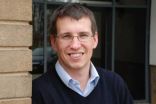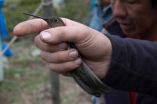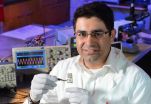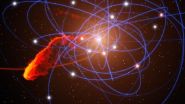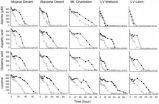(Press-News.org) A UNIVERSITY of Huddersfield criminologist who has been working closely with authorities in London to cut crime on one of the world's busiest transport systems will appear before a House of Commons select committee to describe his findings. Dr Andrew Newton is also forming links with overseas experts so that their research can make public transport systems around the world safer places to travel.
By analysing crime patterns on the London Underground, which carries more than one billion passengers a year, Dr Newton is able to draw conclusions about the environment of stations and how they can help or hinder crime, such as pickpocketing. There are also important lessons to be learned about the policing of the Tube system and the areas that surround stations.
Dr Newton is one of five experts invited to give evidence to the House of Commons Transport Committee during a special session on Monday 7 April. A panel of 11 cross-party MPs – including the Colne Valley's Jason McCartney – will gather information on wide-ranging aspects of security on the railways.
Just published is Dr Newton's co-authored article Above and below: measuring crime risk in and round underground mass transit systems, in the journal Crime Science. It reports on unique research into theft below ground, during Tube journeys. Key findings include the fact that below ground offences are concentrated at particular stations, with the risk being highest during morning and late afternoon peak travel periods, when there is also a greater risk of theft above ground in the nearby environs of the stations.
"The findings suggest that offenders who operate below ground may also operate above ground on major transit systems," writes Dr Newton. "This has clear policy implications for policing these settings and highlights the importance of joint operations and information-sharing between transit agencies and local police forces."
Algorithm to calculate the probability of where theft is most likely
Dr Newton, who is a member of the University of Huddersfield's Applied Criminology Centre, has been researching transit crime since 1999. Two years ago, he was approached by the British Transport Police (BTP) and Transport for London (TfL) – which runs the London Underground – to collaborate on a new crime reduction project. Although crime on the network is incredibly low, with less than 10 crimes per million passenger journeys, TfL and BTP were keen to find new ways to tackle pickpocketing, which accounts for about half of all recorded crime on the London Underground.
"By its nature you don't know when and where you are pickpocketed," said Dr Newton. "You get on at the start of the journey and you might change to a different line. It might not be until the end of the journey that you realise you have been a victim."
This factor creates difficulties for research into the hot spots for theft below ground on the Tube system. Therefore, Dr Newton worked with Transport for London in developing and adapting research methodologies that have helped to identify the locations on the network where there is the greatest likelihood of crime. The research develops upon and uses data from an analytical tool built by the BTP in collaboration with TfL. The tool uses an algorithm to calculate the probability of where theft is most likely to be occurring and help the BTP to target resources more effectively.
Andy Gill, Performance Manager for TfL Enforcement and On Street Operations said: "At TfL, we always want to be at the forefront of ways to tackle crime, especially developing the evidence base for effective solutions for crime reduction, and for that reason we were delighted to be involved in this research. We enabled access to the necessary crime information from the BTP, the Metropolitan Police and the City of London Police Forces, plus passenger journey information to test the model and develop greater understanding of crime interactions between Tube stations and the surrounding environs. Our partnership has shown how research can be practically applied to operational policing, and we are confident this model will help our BTP colleagues maintain low crime upon the London Underground."
Streets, Transport and Crime
Dr Newton will continue his research and to disseminate his findings. He has just spoken at a major seminar organised by University College London in collaboration with TfL, entitled Streets, Transport and Crime. Towards the end of 2013, he delivered an address at a conference in Stockholm on the subject of public transport safety and he discussed his London Underground research at the American Society of Criminology in Atlanta and at an international seminar at California State University San Bernardino, where he is now collaborating with its Center for Criminal Justice, aiming to contribute to a project on safety on the California transit line.
"I would like to develop an international network and I am talking to colleagues in Sweden, North America, and Australia looking at best practice and deciding if the tool we have developed with Transport for London can be rolled out to other areas," said Dr Newton.
He is currently working on a co-authored edited book dealing with crime and mass transit, due to be published in 2015, and has contributed an entry on crime and public transport to the new Encyclopaedia of Criminology and Criminal Justice (Springer).
INFORMATION: END
New study on the crime risk on London Underground
Researcher works with Transport for London developing an algorithm to calculate the probability of where theft is most likely
2014-04-04
ELSE PRESS RELEASES FROM THIS DATE:
New algorithm aids in both robot navigation and scene understanding
2014-04-04
Suppose you're trying to navigate an unfamiliar section of a big city, and you're using a particular cluster of skyscrapers as a reference point. Traffic and one-way streets force you to take some odd turns, and for a while you lose sight of your landmarks. When they reappear, in order to use them for navigation, you have to be able to identify them as the same buildings you were tracking before — as well as your orientation relative to them.
That type of re-identification is second nature for humans, but it's difficult for computers. At the IEEE Conference on Computer ...
Scientists unmask the climate uncertainty monster
2014-04-04
Scientific uncertainty has been described as a 'monster' that prevents understanding and delays mitigative action in response to climate change. New research by Professor Stephan Lewandowsky of the University of Bristol, and international colleagues, shows that uncertainty should make us more rather than less concerned about climate change.
In two companion papers, published today in Climatic Change, the researchers investigated the mathematics of uncertainty in the climate system and showed that increased scientific uncertainty necessitates even greater action to mitigate ...
Key genetic mutations could be new hope for adrenocortical tumor patients
2014-04-04
April 3, 2014, Shenzhen, China - Chinese researchers from Rui-Jin Hospital, Shanghai Jiao-Tong University School of Medicine, BGI, and other institutions have discovered that the activating hotspot L205R mutation in PRKACA gene was closely associated with adrenocortical tumors (ACTs), and the relationship of recurrently mutated DOT1L and CLASP2 with ACTs' other subtypes. The latest study published online in Science opens a new insight into diagnosis and treatment of Adrenal Cushing's syndrome.
Adrenal Cushing's syndrome results from autonomous production of cortisol ...
An ultrathin collagen matrix biomaterial tool for 3-D microtissue engineering
2014-04-04
A novel ultrathin collagen matrix assembly allows for the unprecedented maintenance of liver cell morphology and function in a microscale "organ-on-a-chip" device that is one example of 3D microtissue engineering.
A team of researchers from the Center for Engineering in Medicine at the Massachusetts General Hospital have demonstrated a new nanoscale matrix biomaterial assembly that can maintain liver cell morphology and function in microfluidic devices for longer times than has been previously been reported in microfluidic devices. This technology allows researchers to ...
Hummingbird evolution soared after they invaded South America 22 million years ago
2014-04-04
A newly constructed family tree of the hummingbirds, published today in the journal Current Biology, tells a story of a unique group of birds that originated in Europe, passed through Asia and North America, and ultimately found its Garden of Eden in South America 22 million years ago.
These early hummingbirds spread rapidly across the South American continent, evolved iridescent colors – various groups are known today as brilliants, topazes, emeralds and gems – diversified into more than 140 new species in the rising Andes, jumped water gaps to invade North America and ...
Iowa State scientist developing materials, electronics that dissolve when triggered
2014-04-04
AMES, Iowa – A medical device, once its job is done, could harmlessly melt away inside a person's body. Or, a military device could collect and send its data and then dissolve away, leaving no trace of an intelligence mission. Or, an environmental sensor could collect climate information, then wash away in the rain.
It's a new way of looking at electronics: "You don't expect your cell phone to dissolve someday, right?" said Reza Montazami, an Iowa State University assistant professor of mechanical engineering. "The resistors, capacitors and electronics, you don't expect ...
Watching for a black hole to gobble up a gas cloud
2014-04-04
Right now a doomed gas cloud is edging ever closer to the supermassive black hole at the center of our Milky Way galaxy. These black holes feed on gas and dust all the time, but astronomers rarely get to see mealtime in action.
Northwestern University's Daryl Haggard has been closely watching the little cloud, called G2, and the black hole, called Sgr A*, as part of a study that should eventually help solve one of the outstanding questions surrounding black holes: How exactly do they achieve such supermassive proportions?
She will discuss her latest data at a press ...
Bacteria get new badge as planet's detoxifier
2014-04-04
Las Vegas - A study published recently in PLOS ONE authored by Dr. Henry Sun and his postdoctoral student Dr. Gaosen Zhang of Nevada based research institute DRI provides new evidence that Earth bacteria can do something that is quite unusual. Despite the fact that these bacteria are made of left-handed (L) amino acids, they are able to grow on right-handed (D) amino acids. This DRI study, funded by the NASA Astrobiology Institute and the NASA Exobiology Program, takes a closer look at what these implications mean for studying organisms on Earth and beyond.
"This finding ...
Knowledge, use of IUDs increases when women are offered counseling and 'same-day' service
2014-04-04
PITTSBURGH, April 3, 2014 – Health care clinics should routinely offer same-day placement of intrauterine devices (IUDs) to women seeking emergency contraception, according to researchers at the University of Pittsburgh School of Medicine. The study findings, published online in the journal Contraception, demonstrate that providing patient education along with same-day placement service increases both knowledge and use of IUDs three months and a year after women seek emergency contraception.
"Women seeking emergency contraception, who are at very high risk of undesired ...
Researchers empower parents to inspire first-generation college-goers
2014-04-04
(PHILADEPHIA) – Parents who have not attended college are at a disadvantage when it comes to talking about higher education with their kids – yet these are the students who most need a parent's guidance.
A new approach developed and tested by researchers at University of the Pacific's Gladys L. Benerd School of Education may help solve the problem. It was presented today at the annual meeting of the American Educational Research Association. [April 4, 8:15 a.m. EDT, Philadelphia Convention Center Terrace Level, Terrace IV]
"There is a common perception that low-income ...
LAST 30 PRESS RELEASES:
Heart-brain connection: international study reveals the role of the vagus nerve in keeping the heart young
Researchers identify Rb1 as a predictive biomarker for a new therapeutic strategy in some breast cancers
Survey reveals ethical gaps slowing AI adoption in pediatric surgery
Stimulant ADHD medications work differently than thought
AI overestimates how smart people are, according to HSE economists
HSE researchers create genome-wide map of quadruplexes
Scientists boost cell "powerhouses" to burn more calories
Automatic label checking: The missing step in making reliable medical AI
Low daily alcohol intake linked to 50% heightened mouth cancer risk in India
American Meteorological Society announces Rick Spinrad as 2026 President-Elect
Biomass-based carbon capture spotlighted in newly released global climate webinar recording
Illuminating invisible nano pollutants: advanced bioimaging tracks the full journey of emerging nanoscale contaminants in living systems
How does age affect recovery from spinal cord injury?
Novel AI tool offers prognosis for patients with head and neck cancer
Fathers’ microplastic exposure tied to their children’s metabolic problems
Research validates laboratory model for studying high-grade serous ovarian cancer
SIR 2026 delivers transformative breakthroughs in minimally invasive medicine to improve patient care
Stem Cell Reports most downloaded papers of 2025 highlight the breadth and impact of stem cell research
Oxford-led study estimates NHS spends around 3% of its primary and secondary care budget on the health impacts of heat and cold in England
A researcher’s long quest leads to a smart composite breakthrough
Urban wild bees act as “microbial sensors” of city health.
New study finds where you live affects recovery after a hip fracture
Forecasting the impact of fully automated vehicle adoption on US road traffic injuries
Alcohol-related hospitalizations from 2016 to 2022
Semaglutide and hospitalizations in patients with obesity and established cardiovascular disease
Researchers ‘listen in’ to embryo-mother interactions during implantation using a culture system replicating the womb lining
How changing your diet could help save the world
How to make AI truly scalable and reliable for real-time traffic assignment?
Beyond fragmented markets: A new framework for efficient and stable ride-pooling
Can shape priors make road perception more reliable for autonomous driving?
[Press-News.org] New study on the crime risk on London UndergroundResearcher works with Transport for London developing an algorithm to calculate the probability of where theft is most likely
